

Ottawa Charter - DO OR DIABETES. The World Health Organisation (WHO) arranged an international agreement in Canada called ''Ottawa Charter'' for health promotion in November 1986.

Through this agreed charter, better health for all is hoped to be achieved by 2000 and beyond. In order for this to be achieved, coordinated action by all governments, non- governments, local authorities, industry and the media is required for effective health promotion. The charter consists of five action areas that are widely utilised by the health promotion sector to recognise and prioritise health issues by following the five action areas. The five action areas are utilised to promote better health which is a process of preventing ill health and advancing the health of the entire population through interventions.These action areas include; Developing Personal Skills, Strengthening Community Action, Building Healthy Public Policy, Creating Supportive Environment and lastly, Reorienting Health Services.
What happens if you don't eat a healthy balanced diet? What are the risks? Diet and mental health. There is research to suggest that what we eat may affect not just our physical health, but also our mental health and wellbeing.
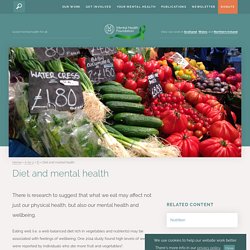
Eating well (i.e. a well-balanced diet rich in vegetables and nutrients) may be associated with feelings of wellbeing. One 2014 study found high levels of wellbeing were reported by individuals who ate more fruit and vegetables1. A recent study found that a Mediterranean-style diet (a diet high in vegetables, fruits, legumes, nuts, beans, cereals, grains, fish, and unsaturated fats such as olive oil.) supplemented with fish oil led to a reduction in depression among participants, which was sustained six months after the intervention.2 The importance of good nutritional intake at an early age is explored in multiple studies, including a systematic review in 2014, which found that a poor diet (with high levels of saturated fat, refined carbohydrates and processed food products) is linked to poorer mental health in children and adolescents3.
*Updated October 2018. Teen eating disorders: Tips to protect your teen. Teen eating disorders: Tips to protect your teen Concerned about teen eating disorders?
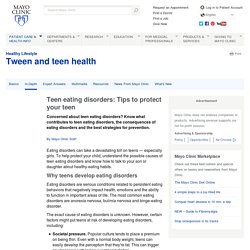
Know what contributes to teen eating disorders, the consequences of eating disorders and the best strategies for prevention. By Mayo Clinic Staff Eating disorders can take a devastating toll on teens — especially girls. To help protect your child, understand the possible causes of teen eating disorders and know how to talk to your son or daughter about healthy-eating habits. Aboutkidshealth. Importance of calcium Calcium is important for bone growth.
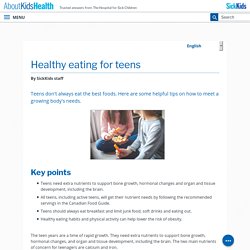
If teens optimize their bone health, they have a decreased risk of teen fractures and of developing osteoporosis during adulthood. Females are particularly at risk if they do not meet their calcium requirements. Females aged 13 to 17 have an intake of approximately 1000 mg/day while the daily recommended intake (DRI) for this age group is 1300 mg/day. Males of the same age meet their requirements at about 1400 mg/day. The following chart lists various dairy and non-dairy sources of calcium: Importance of iron Iron is another important nutrient for teenagers. Females should try to increase their iron intake with some of the following suggestions: Food habits Along with physical changes, teens become more independent as they grow.
How can I help my preteen or teen make healthy snacking choices? There are four major food habits of concern. Skipping breakfast Increased foods from the 'other' food group Increased eating outside the home. Cite This For Me: Harvard, APA, MLA Reference Generator. Obesity in children. Overweight and obesity in Australia: a birth cohort analysis, Table of contents.
Overweight and obesity: an interactive insight, What is overweight and obesity. Source: World Health Organization (WHO) 2000.
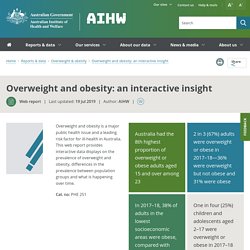
Obesity: preventing and managing the global epidemic. Report of a WHO consultation. WHO technical report series 894. Healthy Eating Poster - Classroom Display by Pink Tulip Teaching Creations. Make learning fun and easy with this bright and colorful healthy eating poster.

A great visual to help your students understand more about the different types of foods. Students can clearly see which foods they should eat in which portions. Includes a black and white version for students to color in and decorate. These posters are sized A3, so if you want A4 make sure you check and adjust sizing before you print.
Encourage Healthy Eating Behaviors and Promote School Lunches – Healthy Food Choices in Schools. Students who eat full, balanced meals everyday are more likely to perform better academically and behaviorally.5 Often, the breakfasts and lunches provided by the school are the best way for children to get the nutrition that they need to concentrate in the classroom.

In order to encourage your students to participate in the school lunch program, try these tips for modeling and promoting healthy eating habits. Eat school lunch yourself. When students see you eating school lunch in the cafeteria, they may be inspired to follow suit. Seeing their teacher eat school lunch will show them that this is an easy, healthy option for mealtime.2 Focus on how different foods make them feel.
Healthy food choices - Department of Education. Eating well and being active are critical to children’s health and wellbeing.
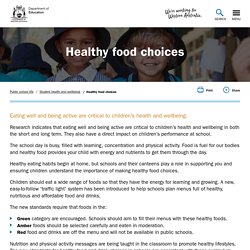
Research indicates that eating well and being active are critical to children’s health and wellbeing in both the short and long term. They also have a direct impact on children’s performance at school. The school day is busy, filled with learning, concentration and physical activity. Food is fuel for our bodies and healthy food provides your child with energy and nutrients to get them through the day.
Healthy eating habits begin at home, but schools and their canteens play a role in supporting you and ensuring children understand the importance of making healthy food choices. Children should eat a wide range of foods so that they have the energy for learning and growing. The new standards require that foods in the: